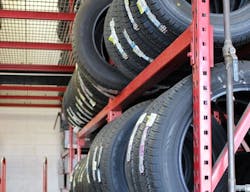This MTD exclusive was provided by John Healy, managing director and research analyst with Northcoast Research Holdings LLC and author of MTD's monthly Your Marketplace column.
Recent dealer commentary suggests that consumer demand for passenger and light truck tires fell on a net basis during July 2022, continuing a trend that we have observed over the last several months.
Less than 25% of the net number of respondents to our latest survey reported that they experienced positive year-over-year demand in June - a smaller percentage than observed in June and May 2022, but a decline nevertheless.
So while the rate of year-over-year decline is improving , we also note that tire manufacturer price increases and inflationary pressures in the broader economy are still working to dampen consumer tire spending.
From a high-level view, we get the feeling that dealers are coming to terms with the fact that consumers are spending less - just as earlier this year, consumers appeared to be coming to terms with increased pricing across all areas of spending.
While we continue to hold the perspective that volumes in the long run will become more closely aligned with current levels of GDP growth, we will be closely watching macroeconomic conditions as GDP growth has now declined for two straight quarters.
Deep dive into miles driven
Given volatile industry conditions due to rampant inflation and geopolitical concerns, we continue to track several data points in order to assess the health of automobile travel demand, which correlates with tire usage and wear.
Looking at miles driven during the past month, trends again declined on a year-over-year basis, with the rate of deceleration increasing in July, which showed a steep 8.7% year-over-year decline versus a 1.8% decline in June 2022.
While gas prices remain a concern, as noted previously, our historical analysis suggests that demand for gas is relatively sticky and poses a more modest threat to further reduction in miles traveled than headlines would have one think.
During the Memorial Day holiday, miles driven increased. But that trend changed in July, as miles driven fell 27.5% on a year-over-year basis during the week of July 4.
While our index is best used to determine longer-term trends, we do note that the picture is not entirely grim as miles driven fell just 2.6% and then rose by 7.6% in the two weeks following the holiday.
While July showed volatility, we feel the recent decline in gas prices is helping stabilize trends in miles driven and vehicle usage. That said, we do believe that pain at the pump - coupled with rising inflation in all areas of consumer spending - is having a negative impact on miles traveled.
We also note that following Russia’s invasion of Ukraine and subsequent fuel price increases in the U.S., the months of April, May, June and July all experienced declines in miles driven.
Raws continue to rise
Turning to raw material costs, the “basket” of raw materials needed to make a common replacement consumer tire rose 31% on a year-over-year basis in July 2022, while also increasing on a sequential basis by 2.1% from June.
This continues the trend of rising raw material price inputs, which began at the start of 2021.
Holding current spot prices flat would yield a 30.1% year-over-year increase in raw material input costs during the third quarter of 2022, which represents a sequential 3.2% increase from the second quarter of the year.
Looking ahead to the fourth quarter, given elevated raw material costs recorded at the end of 2021, we estimate there will be an 18.9% year-over-year increase in the raw material cost to build a tire next quarter - holding current spot prices flat.
In look at specific price movements, we note that carbon black has seen its price increase on a year-over-year basis for 19 months in a row, while jumping 3.9% from June 2022.
July posted a price increase of 59.7% in carbon black.
Examining crude oil, despite recent declines in prices at the pump, overall prices remained elevated on a year-over-year basis in July. We note that July saw a 44.5% year-over-year increase.
The price of reinforcement items continued to track higher on a year-over-year level in July - growing by 41.3%, a strong increase similar to what happened during the previous month.
However, natural rubber prices fell 2.6% on a year-over-year basis in July 2022, while also falling 8.6% on a sequential basis from June 2022 levels.
About the Author

John Healy
John Healy is a managing director and research analyst with Northcoast Research Holdings LLC, based in Cleveland, Ohio. Healy covers a variety of subsectors of the automotive industry and writes MTD's monthly Your Marketplace column. If you would like to be included in the monthly dealer discussions, contact him at [email protected].
